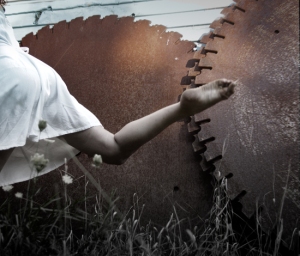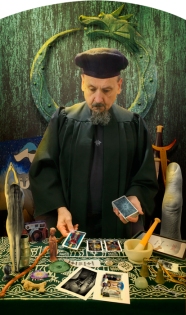Charlie Lemay is a photographer, graphic designer, and digital artist. He is also a full-time Associate Faculty at St. Paul’s School in Concord, New Hampshire, where he teaches Photography, Computer Graphics, and Fine Arts Foundations. His fine art digital and black and white images can be viewed at www.charlielemay.net.

Charlies photograph, titled “Fear of Flight”. A black and white version appeared in Amoskeag’s 2013 issue.
Amoskeag: Your photo is titled “Fear of Flight.” Why? What does it mean to you? What do you want your viewers to take from it?
Charlie: This image was made during a week-long workshop with photographer, Keith Cater, at the Maine Media Workshops in 2010. The woman in the photograph was a fellow photographer who happened to have been a trained ballerina. The class was taken to a place called Elmer’s barn that was full of old rusty metal and antique stuff which provided many opportunities for image making. At one point, the ballerina began to dance and called to the other photographers to make photographs of her dancing. The original image was in color and captured digitally, so the black and white reproduction in Amoskeag is not how it is meant to appear. Shadows in color photographs always appear bluish unless filtered to be neutral the way the eye sees. I knew that the shadow of the trees behind the dancer would give the appearance of a blue sky with fluffy clouds. It was clear from the siding, that this was a backdrop and not an actual sky, and with her head down and crouching as though wanting to take off, I saw it as a doomed attempt to take flight. Fear seemed a plausible reason for not being able to fly. I faded to color toward the bottom, which becomes strictly black and white, to emphasize her being grounded..
Amoskeag: In “Fear of Flight,” the woman’s arms are spread out with her feet planted firmly on the ground. Even though her face is covered by her hair, the creation of story and emotion is still vivid. How do you come to capture that in your photos?
Charlie: Not being able to see the woman’s face, means the head down implies a kind of sadness. The outstretched arms imply an attempt to fly. Her flat feet on the ground imply it is not going to happen. A moment later, of course , she stood straight up and danced away. The moment captured allows us to create an alternative narrative, which is really based on our own assumptions. I made a second photo that day a few minutes before this one. I call it Buzcut. This happened when the model danced away. I was just getting into position on the ground to emphasize the large saw blades in the background and because of the shutter lag time of the digital camera I was using, she was nearly out of the frame when this image was made. All we see are her legs and the edge of her dress in motion juxtaposed with the ominous saw blades. I also faded the color at the bottom on this one and the result again is a sort of grounding that allows the colored top to come to life out of the lifeless black and white bottom. Although there were several other photographers photographing this same scene, none of their images looked at all like these.
Amoskeag: As a commercial photographer and graphic designer, and as an innovator in digital photography, do you struggle to keep these worlds apart?
Charlie: I think commercial work was my alternative to graduate school. When I graduated from Bowdoin College in 1972, I really could not afford to continue my education, so I found a way, to get other people to pay me to keep learning. Everything I have learned in the commercial arena has given me skills and experience I was able to bring to art making. La t summer. I officially retired from commercial design and photography for others and will totally focus on my own projects going forward.
Amoskeag: Your body of artistic work consists of myth and allegory, nature and detail, how do these different ways of seeing fit together?
Charlie: I’m the connection. The Digital Theatre series, which eventually culminated in my Digital Tarot, is totally inspired work. That is, I see each image in my mind before I begin. It may take me years between having the vision for a piece and its completion, so it may change, but the core idea is there from the beginning. I don’t always know what the piece is about me, I only know that I must make it. As I make the piece and live with it over the years, it will reveal itself in some way that teaches me about myself and the world. I have no doubt that I have changed in response to this work in ways that allow me to see the world differently and to make images I would never have made without that incoming experience. When I work in traditional black and white photography, I am using those new eyes to see the everyday world in a new way. So this is me outgoing, recording what I notice with those new eyes. I like to think that the traditional black and white images are my passion and the digital collages my mission. The former my haiku and the later my epic poetry.
Amoskeag: What do you hope to achieve through your work?
Charlie: The job of the artist is to wake themselves up, then to wake up others. That’s what I want to achieve.
Amoskeag: As a teacher, what is the best advice you can give to your students or other aspiring photographers?
Charlie: Learn to see light rather than things.
Eliminate the unnecessary.
Find the extraordinary within the ordinary.
Shed your preconceptions.
Don’t make the images we’ve all seen before. Make the images that if you don’t make them, no one else will ever get to see.
Amoskeag: Whose work has most influenced you, and what do you think sets them apart from others?
Charlie: Illustrators such as Aubrey Beardley and Maxfield Parrish, who made me see the power of myth and mystery. Painter Pablo Picasso, who showed me the power of personal vision and design. Photographers such as Joseph Koudelka and Ralph Gibson who showed me the power of metaphor. And lastly, my mentor, photographer Connie Imboden, who made the connection for me of being in the moment to art making.
Amoskeag: What’s next for you as an artist/photographer?
Charlie: I just completed my first book, “Seeing, Insights + Images,” which will be out in a couple of months. It is a series of 40 black and white images alon side something I have said about my experience in the world. Having the two side by side makes for some interesting contrasts and connections. The first edition of my Digital Tarot will come out and be available by summer. I expect these two projects will take up most of my time over the next few months. Meanwhile, I continue to make black and white images every week. I am also working on a black and white installation piece, which I hope to complete over the next two years, but it is too early to talk about the details of that one. People who follow my website, will be the first to know when that project is nearing completion.



Like your posts. Why no photo of Charlie? Liked the one of the girl’s hand and butt near the menacing round saws. BR Date: Fri, 11 Apr 2014 16:44:47 +0000 To: hillofbeans2@hotmail.com